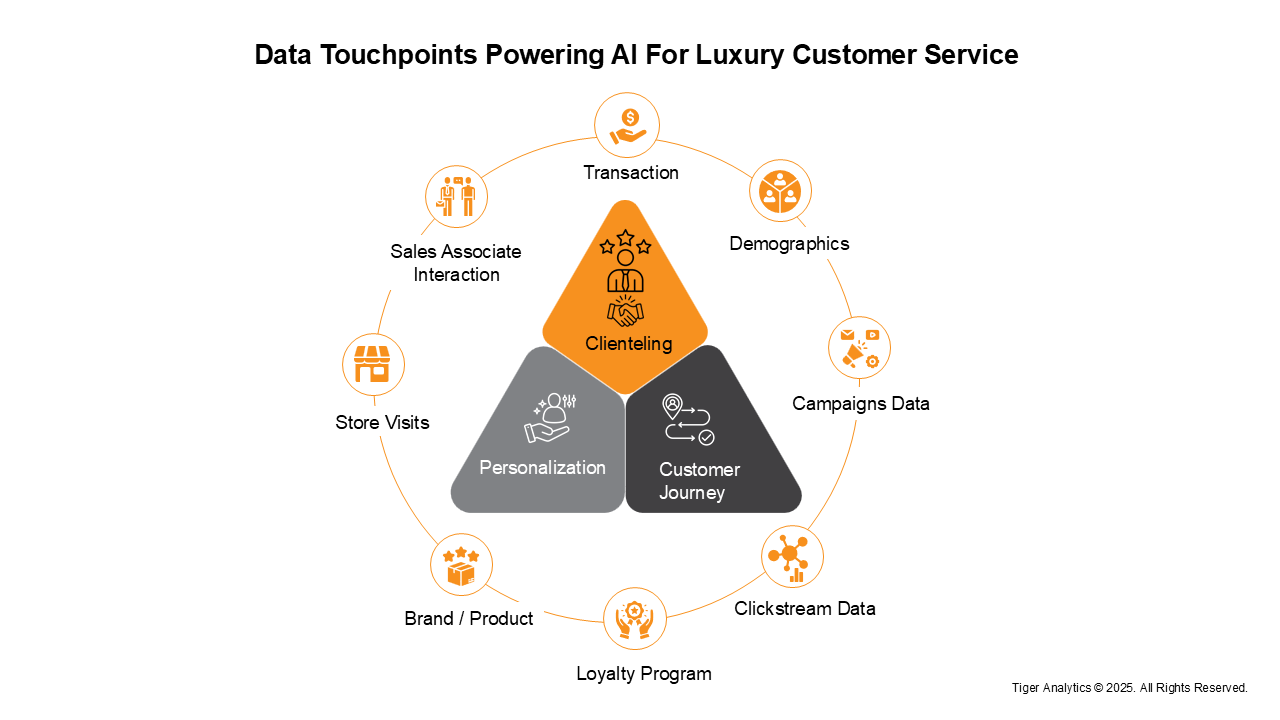The definition of luxury is changing. Today, experiences matter as much as products, research found. As a result, luxury goods retailers must go above and beyond to meet sky-high client expectations and capture spending. While analysts forecast a slowdown in 2025 compared to 2024, the global luxury goods market is still projected to grow from $474 billion in 2024 to $578 billion by 2029.
Success in this demanding market is no easy feat, with changing customer demographics and the requirement for relevant and seamless brand interactions. In addition, the luxury segment, which historically focused on a select range of products for a highly specific audience, has expanded with more categories like sunglasses and fragrances to tap into diverse consumer groups. Retailers are now focused on striking a balance between catering to a diverse clientele while still maintaining their exclusivity and brand prestige.
Using AI to better cater to the needs of luxury customers
Retailers possess a treasure trove of data collected across various customer touchpoints – from offline visits, in-store behavior, offline transactions, and loyalty programs, to digital campaign interactions, online visits, clickstream data, online behavior, online transactions, and more. Integrating AI and ML with this data results in valuable and actionable insights that can help serve customers better. At the same time, it is essential that brands handle their expanse of data responsibly, ensuring compliance with privacy regulations and fostering greater trust among customers. Based on our work, we identified three major areas where AI can aid luxury retailers in improving customer service:
- Clienteling – An approach employed by retail sales associates to build long-term relationships with customers. Luxury retailers can use AI to map the right associate with the customer, and provide the associates with real-time customer data to improve one-on-one experiences.
- Personalization – Tailoring the customer experience across every touchpoint based on their preferences. By leveraging AI, retailers can offer bespoke services such as crafting highly individualized digital content, and offering personalized recommendations.
- Customer Journey – Identifying customer growth opportunities by understanding their experience with the brand and their journey. Using AI, luxury brands can quickly and accurately identify and nurture elite customers, and uncover more growth opportunities.

We now explore each approach in detail.
Clienteling: Fostering deeper engagement with the right customer-sales associate match
Luxury retail is more than just a transaction – it is about curating premier experiences and forming lasting bonds beyond a sale. Sales associates play a critical role in creating these experiences and bonds, particularly in an in-store setup, which presents the full brand identity in all its glory. Sales associates personally guide customers through the brand experience with a curated selection based on preferences, engaging them with personalized product recommendations, providing exclusive access to events or limited-edition products, and maintaining relationships throughout the customer journey.
Similar to how a product’s success depends on positioning it to the right market, the success of clienteling efforts hinges on matching the right sales associate to the customer. Matching a large customer base with the right sales associates, scaling this across different geographies, and continuously updating it based on the customer journey is a complex task.
We partnered with a luxury retailer to create such perfect matches with AI and data analytics. We first consolidated customer-level metrics such as preferred categories, brands, average basket size, average transaction amount, frequency of purchases, number of events attended, invites accepted or rejected etc. Next, we gathered sales associate-related metrics like tenure, experience, repeat customers, and customer feedback (CSAT surveys, post-purchase surveys). We built an AI model to predict the probability of successful pairings resulting in conversions. The business team can further fine-tune these results with incremental rules, such as limiting the number of customers each sales associate handles to manage workloads, or ensuring a minimum number of customers allocated to each sales associate etc., to arrive at the final customer-sales associate pairs. The models must be periodically refreshed based on different scenarios – when the customer moves to a different segment, sales associates exit the system, or when a low level of engagement is observed with a pairing.
The AI-driven models we developed streamlined the customers-sales associates pairing and improved clienteling efforts, resulting in a 50% increase in customer spends and a 100% uptick in engagement.
Personalization: Delivering tailored product recommendations and promotions
Customers interact with brands across channels, and retailers are expected to provide seamless and personalized experiences across all touchpoints. Whether it’s ads, emails, website content, or product recommendations, retailers must master the art of personalization. A study by McKinsey found that companies that grow faster drive 40% more of their revenue from personalization than their slower-growing counterparts. Let us look at how AI can help in personalizing products to recommend and promotions to offer below.
Personalized Product Recommendation Solution
A one-size-fits-all strategy to recommend best-selling products to customers may be necessary when retailers lack user information. However, organizations can make more informed and tailored product recommendations as they gather more details about customers — such as demographics, visit patterns (whether in-store or online), purchase history, and product preferences, including attributes like brand, category, hazard level, and sustainability.
We collaborated with a global beauty retailer on a product recommendation solution that leverages deep learning and graph-based techniques to effectively create embeddings that identify products relevant to individual customers. The identified list of products is further refined according to personal preferences, such as brand and style choices, and search and click history, resulting in a tailored list of offerings that is highly relevant to the individual customer, ultimately improving sales and customer engagement.
Personalized Coupon Selection Solution
Preference towards coupon offers can be very, very different from one customer to another. Some may prefer a flat discount rate, some a few dollars off, and others free shipping. It could also differ based on the product category or brand. The redemption rate for digital coupons is generally low, around 7%, reports found. Hence, it is important to offer the right coupon which will encourage the customer towards redemption.
Our approach here would involve leveraging machine learning to build predictive models. These models would predict the probability of redemption across various promotion combinations, such as low spend with high discount, low spend with low discount, high spend with high discount, high spend with low discount, flat dollars off, and add-on services. Analyzing these probabilities across different customer segments would then help identify the most preferred promotion for each customer. Combine this result with additional details specific to each customer, including preferred brands, recently visited/enquired items, search and click history, loyalty tier, etc, to arrive at a personalized coupon. This approach can help increase redemption rate and drive engagement.
Customer Journey: Identifying high-value clients and unlocking growth opportunities
A study analyzing the global luxury goods market found that the top 2% of customers account for nearly 40% of sales. These elite customers, often referred to as Very Important Customers (VICs), have exceptionally high expectations and a low tolerance for anything less than stellar service. While meeting their demands poses a significant challenge, identifying potential VICs before they reach that status is equally complex. When such VICs are discovered early and nurtured properly, they can yield significant returns. We partnered with a global luxury retailer to explore how AI and data can make this process easier.
Using customer segmentation techniques, retailers can identify groups exhibiting similar purchasing behaviors. This process typically begins with an analysis of the recency, frequency, and monetary value of transactions. We can further refine these groups into micro-segments based on demographics, engagement levels, interests, etc. These methods provide valuable insights into customer behavior. Another vital source of information is the Customer Journey itself. This journey includes the sequence of interactions customers have with brands, sales associates, marketing campaigns, store visits, purchases, etc.
Retailers can identify customers most likely to become VICs by building propensity models with features specific to their initial transactions. They can then differentiate VICs from other customers by examining factors like purchasing power (e.g., deviation between spend value and average spend >5X, changes in order value), purchase interest (e.g., preferred brands, product scarcity), engagement level (e.g., time between sales associate interactions and purchases, duration of engagement), and demographics. Assigning these potential VICs to top SAs and creating personalized journey programs — tailored outreach channels, exclusive event invitations, product recommendations — helps retailers recognize and nurture these valuable relationships early.
Customer Journey details can also be used to better identify cross-sell and upsell opportunities. We collaborated with a global luxury retailer to explore this opportunity. Techniques such as Dynamic Time Warping (DTW) can help recognize customers who follow similar purchasing paths. Upon comparing these patterns with the ideal customer profile, retailers can identify products that are suitable for upselling and cross-selling.
The performance of these models can be improved by adding constraints on the training data such as customers who have been part of the system for a certain period of time, made a minimum number of transactions, and purchased across brands/categories/sub-categories. The recommended products can also be refined further based on historical purchasing trends and favored brands. The retailer we partnered with saw a 2X increase in average revenue generated per customer using this cross-sell and upsell solution.
The luxury goods market is undergoing significant transformation as it adapts to changing customer expectations and demographics. By leveraging AI and data analytics, luxury retailers have the opportunity to exceed these expectations, offering personalized and seamless experiences that foster loyalty and drive growth. From refining clienteling practices to personalizing product recommendations and understanding the customer journey, AI can empower retailers to create more meaningful, long-lasting relationships with their customers. By embracing these technological advancements, luxury brands can navigate the complexities of this evolving market, turning challenges into opportunities and ensuring they remain at the forefront of customer satisfaction and operational efficiency.
References:
https://www.expertscoop.com/2020/05/paper-vs-digital-coupons.html
https://cdn.luxe.digital/download/Altagamma-Bain-Worldwide-Luxury-Market-Monitor-2022-luxe-digital.pdf
https://www.statista.com/outlook/cmo/luxury-goods/worldwide
https://www.mckinsey.com/industries/retail/our-insights/state-of-luxury





